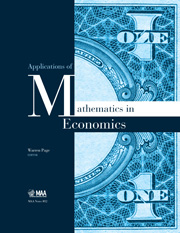Book contents
- Frontmatter
- Contents
- Preface
- Notes on the Sections
- Problems and Subject Areas
- 1 Microeconomics
- 2 Scenarios Involving Marginal Analysis
- 3 Intermediate Macroeconomics Theory
- 4 Closed Linear Systems
- 5 Mathematics in Behavioral Economics
- 6 Econometrics
- 7 The Portfolio Problem
- 8 Topics in Modern Finance
- 9 Maximizing Profit with Production Constraints
- About the Editor
- About the Authors
9 - Maximizing Profit with Production Constraints
- Frontmatter
- Contents
- Preface
- Notes on the Sections
- Problems and Subject Areas
- 1 Microeconomics
- 2 Scenarios Involving Marginal Analysis
- 3 Intermediate Macroeconomics Theory
- 4 Closed Linear Systems
- 5 Mathematics in Behavioral Economics
- 6 Econometrics
- 7 The Portfolio Problem
- 8 Topics in Modern Finance
- 9 Maximizing Profit with Production Constraints
- About the Editor
- About the Authors
Summary
Introduction
Mathematical applications to economics are rarely introduced in Calculus II or III. This is a missed opportunity since so many important concepts in second and third semester calculus courses can be discussed in terms of production, profit, utility, and social welfare functions, which are central to microeconomics. In this paper, we focus on mathematical techniques for optimizing profit functions with and without constraints. We illustrate these techniques with examples, and provide additional problems at the end of each section for student use.
Section 2 (Production Functions) introduces production functions and discusses several of their key properties. Section 3 (Unconstrained Optimization) looks at profit maximization problems and shows how a function's matrix of second-derivatives can be used to determine the function's concavity. In Section 4 (Constrained Optimization), we use the method of Lagrangian multipliers to solve optimization problems with one or more constraints, and explain how to modify the second-derivative test for a constrained maximization problem. We also discuss the significance of the Lagrange multiplier as a shadow price, and how it measures the amount of increase in the objective function as the constraint increases (for instance, the increase in maximal production resulting from an increase in the total budget). Section 5 (Optimization with Inequality Constraints) provides a brief introduction to optimizing production when the constraints are expressed as inequalities as, for example, when a firm can use some, but not all, of its resources.
- Type
- Chapter
- Information
- Applications of Mathematics in Economics , pp. 115 - 130Publisher: Mathematical Association of AmericaPrint publication year: 2013



